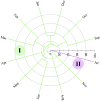Seasonal influence on the essential oil chemical composition of Hyptis crenata Pohl ex Benth.: a valuable plant from Marajó, Brazil
- PMID: 38863674
- PMCID: PMC11165112
- DOI: 10.3389/fchem.2024.1397634
Seasonal influence on the essential oil chemical composition of Hyptis crenata Pohl ex Benth.: a valuable plant from Marajó, Brazil
Abstract
Introduction: Essential oils (EOs) from the Hyptis genus have been reported as bactericides and fungicides. However, the properties of these oils can be affected by climatic factors, as well as the collection period, which promotes changes in the chemical composition of the oil. In this context, this study aimed to evaluate the climatological influences on the chemical composition of the essential oil from the leaves of Hyptis crenata. Methods: The leaves were collected in Marajó island (Brazil) monthly for a year. The EOs were obtained by hydrodistillation and analyzed by Gas Chromatography coupled to Mass Spectrometry (GC-MS). Pearson's correlation was used to evaluate the relationship between climatic parameters, content, and chemical composition of essential oil; multivariate analysis was used to evaluate the interrelationship between samples and their chemical constituents. Results and Discussion: The constituents with the highest contents (>2.0%) in essential oils during the studied period were 1,8-cineole (28.48% ± 4.32%), α-pinene (19.58% ± 2.29%), camphor (11.98% ± 2.54%), β-pinene (9.19% ± 1.47%), limonene (6.12% ± 3.15%), α-terpineol (2.42% ± 0.25%) and borneol (2.34% ± 0.48%). β-Pinene significantly correlated (p < 0.05) with precipitation and humidity. According to the chemometric tools, two groups were formed: chemical profile I, marked by 1,8 cineole, α-pinene, β-pinene, borneol, α-terpineol, and limonene, while group II (July) presented a chemical type characterized by camphor. It is understood that the species in question can be a reliable source of biologically active components during different climatic periods in the Amazon. The chemical variability could have significant implications for the pharmaceutical industry and traditional medicine.
Keywords: medicinal plant; monoterpenes; salva-do-Marajó; seasonality; volatiles.
Copyright © 2024 de Lima, Santos, Jerônimo, Viana, da Silva, Setzer, Maia and Figueiredo.
Conflict of interest statement
The authors declare that the research was conducted in the absence of any commercial or financial relationships that could be construed as a potential conflict of interest.
Figures







Similar articles
-
Chemical composition and antinociceptive and anti-inflammatory activity of the essential oil of Hyptis crenata Pohl ex Benth. from the Brazilian Amazon.J Ethnopharmacol. 2023 Jan 10;300:115720. doi: 10.1016/j.jep.2022.115720. Epub 2022 Sep 13. J Ethnopharmacol. 2023. PMID: 36113677
-
Chemometrics of the Composition and Antioxidant Capacity of Hyptis crenata Essential Oils from Brazil.Molecules. 2023 Apr 11;28(8):3371. doi: 10.3390/molecules28083371. Molecules. 2023. PMID: 37110606 Free PMC article.
-
Gastroprotective effects of the essential oil of Hyptis crenata Pohl ex Benth. on gastric ulcer models.J Ethnopharmacol. 2013 Oct 7;149(3):694-700. doi: 10.1016/j.jep.2013.07.026. Epub 2013 Aug 3. J Ethnopharmacol. 2013. PMID: 23920251
-
Essential oils from the Hyptis genus--a review (1909-2009).Nat Prod Commun. 2011 Nov;6(11):1775-96. Nat Prod Commun. 2011. PMID: 22224308 Review.
-
Chemical Diversity and Biological Activities of Essential Oils from Licaria, Nectrandra and Ocotea Species (Lauraceae) with Occurrence in Brazilian Biomes.Biomolecules. 2020 Jun 5;10(6):869. doi: 10.3390/biom10060869. Biomolecules. 2020. PMID: 32517106 Free PMC article.
Cited by
-
Seasonal changes in the essential oils of Aloysia oblanceolata Moldenke.Front Chem. 2025 Jun 20;13:1564404. doi: 10.3389/fchem.2025.1564404. eCollection 2025. Front Chem. 2025. PMID: 40620358 Free PMC article.
-
Antibacterial Activity of Eucalyptus Essential Oils in Both Culture Media and Coated Materials.Int J Microbiol. 2025 May 26;2025:2756030. doi: 10.1155/ijm/2756030. eCollection 2025. Int J Microbiol. 2025. PMID: 40470303 Free PMC article.
References
-
- Adams R. P. (2007) Identification of essential oil components by gas chromatography/mass spectrometry. Carol Stream, Ilinois, EUA: Allured Publishing Corporation.
-
- Bezerra S. M. (2020). Agrobiodiversidade e conhecimentos locais das plantas alimentícias no quilombo de Deus Ajude, Arquipélago do Marajó – Pará. Universidade Federal do Pará e Empresa Brasileira de Pesquisa Agropecuária. Available at: https://repositorio.ufpa.br/jspui/handle/2011/14487.
-
- Botrel P. P., Pinto J. E. B. P., Araújo A. C. C. de, Bertolucci S. K. V., Figueiredo F. C., Ferri P. H., et al. (2010a). Variações no teor e na composição volátil de Hyptis marrubioides EPL: cultivada no campo e em casa de vegetação. Quim. Nova 33, 33–37. 10.1590/S0100-40422010000100007 - DOI
-
- Botrel P. P., Pinto J. E. B. P., Ferraz V., Bertolucci S. K. V., Figueiredo F. C. (2010b). Teor e composição química do óleo essencial de Hyptis marrubioides Epl., Lamiaceae em função da sazonalidade. Acta Sci. Agron. 32. 10.4025/actasciagron.v32i3.3415 - DOI
-
- Campos A. C. de S., Costa Neto S. V., Jardim M. A. G. (2021). Floristica, estrutura e formas de vida da regeneração de uma savana amazônica, Pará, Brasil. Rev. Bras. Geogr. Física 14, 2550–2572. 10.26848/rbgf.v14.5.p2550-2572 - DOI
LinkOut - more resources
Full Text Sources
Miscellaneous

